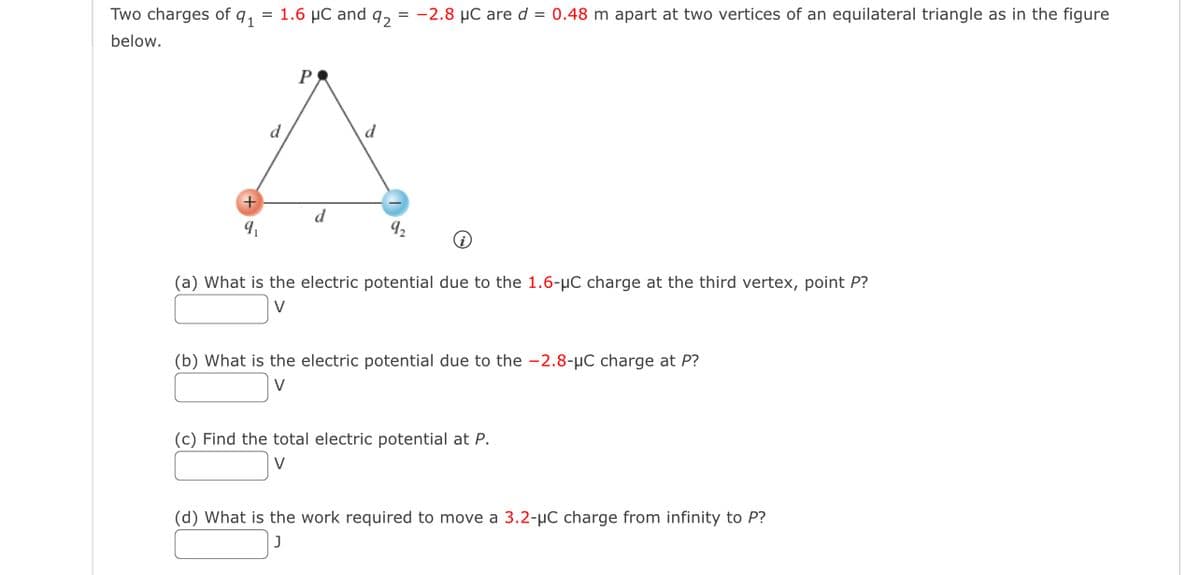Two charges of q1 = 1.6 µC and q2 = −2.8 µC are d = 0.48 m apart at two vertices of an equilateral triangle as in the figure below. Two charges and a point are located at the vertices of an equilateral triangle with side length d. Positive charge
Two charges of q1 = 1.6 µC and q2 = −2.8 µC are d = 0.48 m apart at two vertices of an equilateral triangle as in the figure below. Two charges and a point are located at the vertices of an equilateral triangle with side length d. Positive charge
College Physics
11th Edition
ISBN:9781305952300
Author:Raymond A. Serway, Chris Vuille
Publisher:Raymond A. Serway, Chris Vuille
Chapter16: Electrical Energy And Capacitance
Section: Chapter Questions
Problem 18P: A positive point charge q = +2.50 nC is located at x = 1.20 m and a negative charge of 2q = 5.00 nC...
Related questions
Question
Two charges of
q1 = 1.6 µC
and
q2 = −2.8 µC
are
d = 0.48 m
apart at two vertices of an equilateral triangle as in the figure below.
Two charges and a point are located at the vertices of an equilateral triangle with side length d.
- Positive charge q1 is at the bottom left vertex.
- Negative charge q2 is at the bottom right vertex.
- Point P is at the top vertex.
(a) What is the electric potential due to the 1.6-µC charge at the third vertex, point P?
V
(b) What is the electric potential due to the
V
(c) Find the total electric potential at P.
V
(d) What is the work required to move a 3.2-µC charge from infinity to P?
J
V
(b) What is the electric potential due to the
−2.8-µC
charge at P?V
(c) Find the total electric potential at P.
V
(d) What is the work required to move a 3.2-µC charge from infinity to P?
J

Transcribed Image Text:Two charges of 91 = 1.6 μC and 92
below.
+
9₁
d
P
d
= -2.8 µC are d = 0.48 m apart at two vertices of an equilateral triangle as in the figure
9₂
(a) What is the electric potential due to the 1.6-μC charge at the third vertex, point P?
V
(b) What is the electric potential due to the -2.8-μC charge at P?
V
(c) Find the total electric potential at P.
V
(d) What is the work required to move a 3.2-μC charge from infinity to P?
Expert Solution
This question has been solved!
Explore an expertly crafted, step-by-step solution for a thorough understanding of key concepts.
This is a popular solution!
Trending now
This is a popular solution!
Step by step
Solved in 3 steps with 3 images

Knowledge Booster
Learn more about
Need a deep-dive on the concept behind this application? Look no further. Learn more about this topic, physics and related others by exploring similar questions and additional content below.Recommended textbooks for you

College Physics
Physics
ISBN:
9781305952300
Author:
Raymond A. Serway, Chris Vuille
Publisher:
Cengage Learning

College Physics
Physics
ISBN:
9781285737027
Author:
Raymond A. Serway, Chris Vuille
Publisher:
Cengage Learning

Principles of Physics: A Calculus-Based Text
Physics
ISBN:
9781133104261
Author:
Raymond A. Serway, John W. Jewett
Publisher:
Cengage Learning

College Physics
Physics
ISBN:
9781305952300
Author:
Raymond A. Serway, Chris Vuille
Publisher:
Cengage Learning

College Physics
Physics
ISBN:
9781285737027
Author:
Raymond A. Serway, Chris Vuille
Publisher:
Cengage Learning

Principles of Physics: A Calculus-Based Text
Physics
ISBN:
9781133104261
Author:
Raymond A. Serway, John W. Jewett
Publisher:
Cengage Learning

Physics for Scientists and Engineers, Technology …
Physics
ISBN:
9781305116399
Author:
Raymond A. Serway, John W. Jewett
Publisher:
Cengage Learning

Physics for Scientists and Engineers
Physics
ISBN:
9781337553278
Author:
Raymond A. Serway, John W. Jewett
Publisher:
Cengage Learning

Physics for Scientists and Engineers with Modern …
Physics
ISBN:
9781337553292
Author:
Raymond A. Serway, John W. Jewett
Publisher:
Cengage Learning